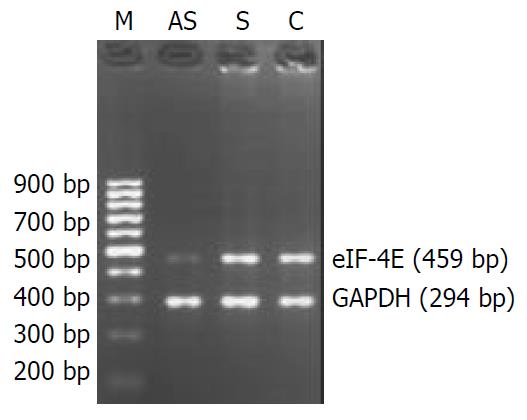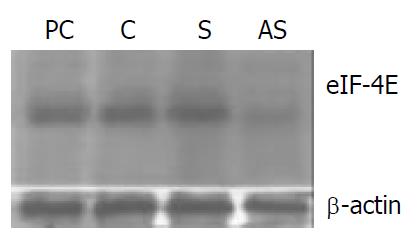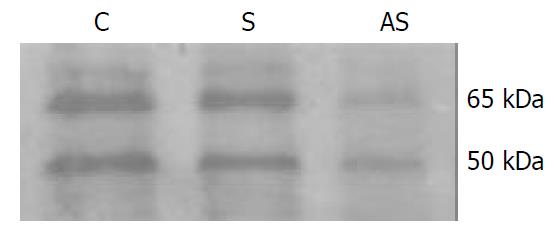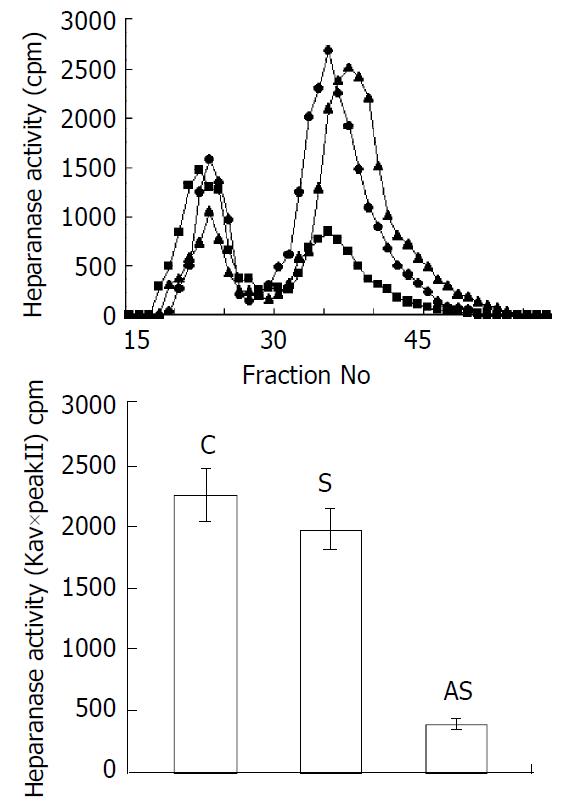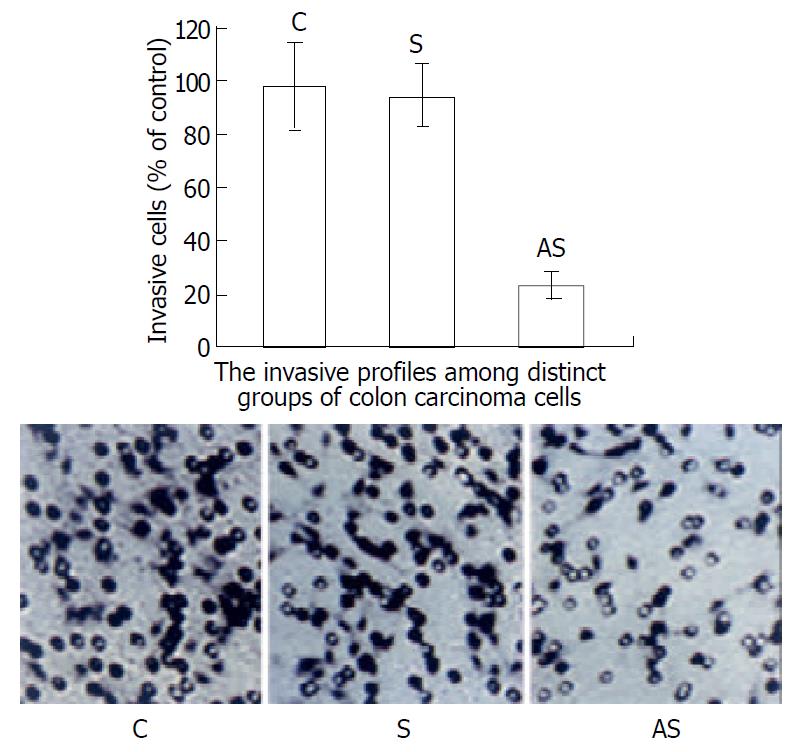Copyright
©The Author(s) 2003.
World J Gastroenterol. Aug 15, 2003; 9(8): 1707-1712
Published online Aug 15, 2003. doi: 10.3748/wjg.v9.i8.1707
Published online Aug 15, 2003. doi: 10.3748/wjg.v9.i8.1707
Figure 1 eIF-4E and GAPDH mRNA expression in oligonucle-otide-treated human colon adenocarcinoma cells.
AS. anti-sense oligonucleotide-transfected cells; S. sense oligonucleotide-transfected cells; C. cells treated with liposome only as control. LS-174T cells were treated with 2 μM oligonucleotides, accord-ing to the optimal condition of this cell line in the preliminary experimental results. The numbers under each band showed the relative amount of eIF-4E fragments normalized to that of GAPDH by densitometry. The results suggest that antisense oligonucleotides against eIF-4E inhibit eIF-4E mRNA expres-sion in LS-174T cells, and sense oligonucleotides have no in-hibitory effect on eIF-4E mRNA expression.
Figure 2 eIF-4E protein expression in oligonucleotide-treated colon adenocarcinoma cells.
Protein extracts were prepared from oligonucleotide-treated cells at 48 h after transfection. Cell lysates were size-fractionated by 12% SDS-PAGE, and immunodetection on the blotted membrane was performed using the eIF-4E MAb. AS, antisense oligonucle-otide-treated cells; S. sense oligonucleotide-treated cells; C, cells treated with liposome only; PC, eIF-4E standard anti-gen (derived from a human neuroblastoma cell line) as a positive control marker.
Figure 3 Western blot analysis of heparanase expression in LS-174T cells.
The colon adenocarcinoma cells were lysed, and Western blot analysis was performed with an anti-hu-man heparanase polyclonal antibody. AS, antisense oligo-nucleotide-treated cells; S. sense oligonucleotide-treated cells; C, cells treated with liposome only. Cells treated with anti-sense oligonucleotides showed markedly reduced levels of heparanase protein compared to cells treated with sense oli-gonucleotides or saline in the presence of liposome. The ap-proximately 65-kDa protein represents a heparanase precursor, whereas the 50-kDa protein is a processed form, and data showed that both of them were less expressed while eIF-4E was inhibited.
Figure 4 Effects of eIF-4E down-regulation upon enzyme activity of heparanase.
Cells were treated for 48 h with antisense oligonucleotide (■), sense oligonucleotide (▲) or liposome only(◆). The soluble fraction from transfected, freezed and thawed LS-174T cells was incubated with 35S-la-beled HS. The incubation medium was then subjected to gel filtration over Sepharose CL-6B. Low-molecular-weight HS degradation fragments (peak II) were mainly produced dur-ing incubation with medium conditioned by sense oligonucle-otide infected cells. The cells treated with antisense oligonucle-otide exhibited low levels of heparanase activity as compared to untreated ones. Heparanase activity was also expressed as Kav×total cpm eluted in peak II.
Figure 5 Invasive profiles of LS-174T cells measured in vitro using Matrigel as ECM barrier in modified Boyden chambers.
The invasiveness of the cells on Matrigel was normalized to 100% (control, untreated cells). Compared with the control, antisense oligonucleotide reduced invasion to 23%. Sense sequence didn’t have a significant influence on invasive potential of LS-174T cells. These results suggest that alteration of heparanase activity via inhibition of the expression of eIF-4E results in decreased inva-siveness in LS-174T cells. The small rings are membrane pores.
- Citation: Yang YJ, Zhang YL, Li X, Dan HL, Lai ZS, Wang JD, Wang QY, Cui HH, Sun Y, Wang YD. Contribution of eIF-4E inhibition to the expression and activity of heparanase in human colon adenocarcinoma cell line: LS-174T. World J Gastroenterol 2003; 9(8): 1707-1712
- URL: https://www.wjgnet.com/1007-9327/full/v9/i8/1707.htm
- DOI: https://dx.doi.org/10.3748/wjg.v9.i8.1707









